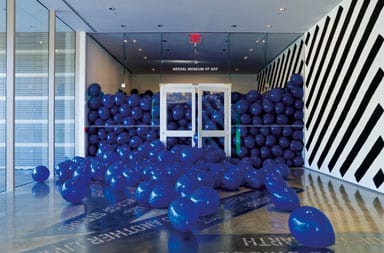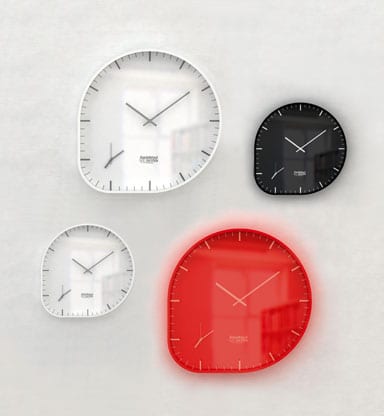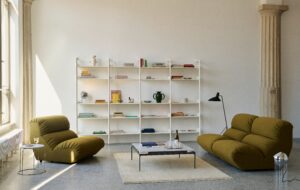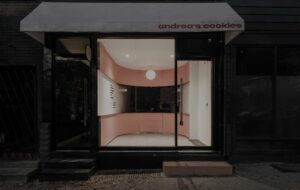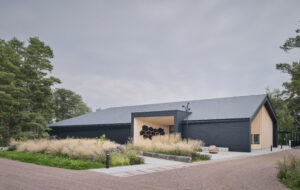
Conversation between Sam Hecht, co-founder of Industrial Facility, and artist Martin Creed. London, 2 October 2008.
Sam Hecht It very rarely happens that designers and artists have any kind of conversation on a similar plateau, and I know that a lot of designers are thinking about similar things but they are fundamentally on a much more commercial level. We are about selling stuff, so in some ways I guess there is always a slight second-hand nature to the way we project ideas to companies and customers compared to art. I am very influenced by art but it’s always a kind of second-hand route.
Martin Creed I think … lately, I cannot see the difference between design and fine art. I actually design my works, you know. I think of it like that. And I often think my work, which bears a resemblance to a design project, has to have a function – it has to fill a certain amount of space or to fill some time or to cause a diversion for a little while. I think that’s what helps me make and finish work.
SH I think a lot of people would say that the fundamental difference between design and art is function, that design has a function and that art is not necessarily about function.
MC I disagree with that, totally.
SH And I totally do too. I find that, actually, if anything, the function of art is to get people to think about who they are, where they are and what kind of life we are living.
MC But … not just to think but even, let’s say, be entertained or to have a good time.
SH What do you think about art as entertainment? Because I remember a couple of years ago I went into your elevator [Work No 371, 2004] and I was immediately struck by how entertaining it was. But also how in some ways how logical it was, how you’re going higher and the sound goes higher. To me it wasn’t just about entertainment, there was some kind of sensorial feeling. I don’t want to read into it too much but I see a lot of work – design work – where the starting point is only about entertainment. And I find that really frustrating. So if we are talking about sitting in a chair or making a cup of tea and design is seen as an entertaining concept then it doesn’t actually deliver what the whole purpose of the object is. I’m just curious – I mean, you mentioned entertainment – about whether art is for you a starting point or an inevitability?
MC I think that, I’m happy if my work is entertaining. The reason I do my work is to try to make my life better. So, if I’m enjoying myself in my experience … I like to enjoy myself, so my life is then better, you know. But some kinds of enjoyment are not enough. For example, I think one difficulty is if things are funny. A lot of works by other people and some works of mine make me laugh – but I don’t know how to make funny works. I don’t know that any more than I know how to entertain people. But I try to entertain myself. I suppose that’s what I do. It works as a sort of diversion, basically, or for me it’s also comfort from the difficulties of life. And that’s its function, to help me, and hopefully others, but first of all me, to get through life.
SH So in some ways you are saying it’s quite self-fulfilling.
MC Yeah.
SH And yet it feels very easy to enter for other people. To me, it feels there is a conceptual layer to it but that layer is not particularly … you don’t need to be intellectual to enjoy it. You get other forms of art which are very fulfilling but it’s really difficult to get into them, because it’s just the artist and their mind and you need to do a lot of study, or you need to …
MC I know, a lot of that type of art is like masturbation in that sense. It’s not so good to watch, you know, without taking part. I hope my work is open to people to come in and use it. I think if I make a work that succeeds, I can let it go into the world and if it succeeds it’s because people make it succeed by using it for whatever purpose: food for thought or to entertain themselves for a few minutes. So, I like to distinguish between my bit in it and everyone else’s use of it. And that function of the work for me may be quite different from the function of the work for someone else. I suppose you can replace the word function with meaning, so the meaning of the work for me is maybe quite different from the meaning for someone else. Maybe that’s why we are so mixed up, because of the word “meaning” in art … in design you would replace it with the word “function”, when in fact they are the same thing. Probably.
SH In my work, meaning is something I’m getting less and less interested in. When you think about something and you design something, you obviously have this thing in your head you want to express. Basically, there are ideas you want to generate in the work. But now I have very little interest in trying to reveal those ideas. The person buying or using the product, whether they get it or not, it doesn’t really matter to me. I like it myself because that’s what generated the process, but if it needs to be explained I don’t feel it has really succeeded. When I see people using the things I’ve done, and they are completely oblivious to what was necessarily behind it, I’m fine. Whereas before I always felt: “Ah, but you don’t understand where it came from. That’s not the idea – the idea is this!”
MC I agree with that totally. I think that whatever I might put into the work is not necessarily what people might get from it. My journey towards the end result is not necessarily going to be visible to the viewer of the end result. One thing that I don’t like when I see exhibitions or works, and I feel as if the artist is still standing there with the work saying, “Look at it that way, this way, remember …” And that’s someone that can’t quite let go of the work and let it be free. You can’t control people, you know, the audience. I think that some artists think that they can, as if one thing leads to another.
SH And also controlling the views and positions that you take.
MC I mean I hate feeling as if I’m being told what to think. I think working and making things is a matter of trying to get back to that kind of position where there is a freedom from prejudice. It’s like what Picasso said: “When I was 16 I could draw like Tintoretto but it took me a lifetime to learn to draw like a child.” When I put a work in its place I think I’m presenting this for people to look at. And the gallery is a theatre for viewing objects, just like a cinema is a theatre for viewing films, that’s what I think of the gallery. But also in that theatre there are other things which are just as valid, whatever, you know, like a light switch or other things to look at along with the things I put in there. And I think if I’m on the Tube and if I see something, a beautiful person or some funny sticker I think I might have an experience like that of seeing a beautiful artwork. So that in my mind is the same as a beautiful artwork. When I go to see a picture, so often the planning and the self-consciousness of going to the picture spoils the experience because you are not free to enjoy or not enjoy it and you are standing here, you know, looking at the Mona Lisa, and you go, “OK, I’m standing here, here I am.” Whereas if you are just walking around and you see something and you think “great!” or you look at the wallpaper next to the picture. But it’s difficult to be free in that way. I think of it as the New Year party syndrome where everyone has to have a good time, and feels they have to have a good time, and it’s usually the time when you don’t have a good time, I find.
SH In a parallel, to me, whenever I see my work in a shop I’m always super-disappointed.
MC Oh, really? Why?
SH It happened to me a couple of weeks ago. There was one of these fairs and they had a product launch and I looked at it and I thought: “God, this is disastrous, it just looks so bad, so tacky.” Like the people who were displaying it didn’t understand a thing, clearly. And I was devastated because I had just slaved away with our studio getting this product made, and tooled up, and perfected. And then they send me some and they are in our studio and it’s a completely different experience, and you think: “Ah, this is pretty good.” But the context or the environment – in this case, the shop where it was shown – it just made you feel like you could vomit. It was surrounded by other crap and it just looked like crap. But when you pull it out of that context, out of the world of the shop, it suddenly had a totally different quality. You kind of described it, already, something in a gallery compared to something in the Tube. You do have a different experience. The normal example would be a work that would look crap in someone’s home but if you have it in the Gagosian, it’s superb.
MC I would want it to look good everywhere, except I’m aware it would look different, possibly better in certain places but I think of exhibitions as a testing out of the work. I mean, I see works as sort of experiments, anyway. I only really find out about the work when I put it to the public and then I can actually start to understand if the work works or not.
SH Would you ever change the work?
MC Absolutely, yes. I don’t know how, when I say that. Maybe the next thing I make I’ll change a bit. Another thing is art fairs, you know, a very brutal exhibition situation which works like a jumble sale, you know. Your description of seeing your work in a shop reminds me of some of the times I’ve seen my work in art fairs.
SH You get deeply disappointed.
MC Exactly. It’s a good way to kill your idealism. But now I think, I want my work to survive in hostile environments. I think that a useful model is trying to make a work like a football, a complete thing that can be kicked around by other people, can be used and played with, can be enjoyed but can’t be destroyed because it’s designed to be kicked around. That’s very much the way I think. And I think that’s why I make a lot of work that doesn’t have a physical, material presence. It’s work that can be realised using a set of instructions, in other words, like a theatrical event, like the lights going on and off. And I think that directly comes from feeling absolutely destroyed when these objects I made were exhibited and handled wrong and damaged and destroyed, in shipments around the world. You know, some of the first kind of more provincial art objects I used to make. I just hated it. At least with the lights going on and off every time it’s made, it’s new.
SH Let’s talk a bit about the lights, the material and the immaterial as well. Just talking in an arts context, when I was younger, it was very difficult to grapple with the idea of something with value that didn’t have a material connection. But now I feel very, very confident with that concept. In design, the parallel would be that the digital has in some ways less value than its physical manifestation, that there is no physical presence to it.
MC It makes me think that the idea of credit is also a similar one because there is actually no money but there is money.
SH That’s true. I guess we are suffering from that at the moment. Money is just a symbol of something. And that gives us comfort in knowing how to handle it. I was in Chicago last week and in the hallway out of the office there was this light that kept going on and off. And no one said anything. There was a kind of normality, an acceptance of that. Probably, people thought there was a bad fluorescent, some faulty wiring, you know. Only when I asked the question, [I was told] “Oh, yeah, it’s the sensor’s gone funny.” It was supposed to go on at night, and off during the day, but it was too sensitive, so when a cloud passes it turns off, when the cloud moves back … But of course, it was happening rapidly. And I think it’s connected with that feeling a bit that when you get into those realms anything is possible, almost. I’m curious … first of all, what your opinion is of the value of the materiality. What happens when you remove those kinds of materialities? And secondly what do you think the value of the digital world experience compared to the non-digital?
MC I think that it’s immateriality which keeps things going. That is, feelings, hope and desire. Immateriality is what makes me and people do things, and want things, you know. But you can’t control what people think, you can’t control immateriality. What you can control is what you do in your own actions and you can to a certain extent, and if you are making a thing, you can control to a certain extent it shape, size and the materials from which it’s made, and so on. But always knowing that that thing is just a thing and that value is given to it by people. So, it’s a controlled thing but it works through uncontrollable urges or forces. And your description of the light that’s responding too sensitively to the clouds strikes me as being opposite to the work of the lights going on and off. I think of my work as being something that’s for me a comfort, something reliable, like putting a measuring tape against the world, with regular increments. Basically, it’s like a hand, something to hold on to in the ever-changing world, you know. That’s the way I think of a lot of my work.
SH So, it’s not a random …
MC No. It’s a comfort, like a handrail or a ladder, or like a beat in music. The repetition of the beat is a comfort.
SH I think what you said is quite interesting in the way that technology develops to remove the human from the equation to get better. And what you are saying is actually participation is what makes it better. The actual immateriality of the participation is what makes the physical better.
MC Exactly. So it’s the humans that …
SH Technologies will generally say, “They are a pain, they don’t follow the rules, they fuck it up. If we could just get them out of the way.” And that’s how the situation happens …
MC Your reaction is a good one because in that situation the humans are annoyed basically by stupid technology, we could say.
SH It comes about because you are faced with the possibilities. So, if you could do it, you will try it, rather than actually saying, “Well, it’s actually not a good idea.” Humans are not as streamlined. Odd things happen. We live in a very odd world …
MC It looks to me like technology, and it’s my own experience, I’m scared of just being there, you know, on my own in an empty world, and so often you try and fill your world with things that divert you from the loneliness of life. One thing you might do is think that you can make life better by having a light you don’t have to have to switch on and off yourself, you know. And that’s a whole diversion. That could be a way of avoiding your sad life. You have to be careful of that. It’s important to be able to face up to oneself. I see the danger all the time in my work of getting carried away. The danger actually is that one work leads to another in a sort of artistic feeling of being successful, or commercial success. And before you know it you get far away from the very first reason … There’s a danger as you go from work to work, you take each last work as a kind of given, as if it’s a good starting point for the next one. But maybe it isn’t. Maybe that work has flaws in it that you actually have forgotten about because it sold quite well and now you just think it’s great. You have to keep going back to the beginning, I think, as if you’ve never made anything before.
SH How do you deal with that personally? Do you rely on critics or do you rely on yourself? Or do you have people in your studio to … how do you have a critical platform to your work?
MC I think I do it mostly by going out and interpreting things …
SH And hearing what people say.
MC Yes, hearing what people say but more seeing how I feel when my works are out. I think they can be excruciatingly bad and you may not know that. But I also have an assistant who is a very good, he’s quite tough, he’s a good editor, he’s a good sounding board. He doesn’t just say yes.
SH Well, that’s what I was going to say. In exhibitions, it’s very hard for people to say, “I don’t like it”. You never quite know, and generally the press … you don’t get as much critical analysis as you get in art.
MC A lot of art criticism compares works to other works in the past. I don’t know if that happens in design.
SH Yes, it does.
MC It happens in most fields. I know in music they say: “This band is like this other band. This is like the Beatles mixed with Bob Marley.”
SH Do you get the pressure of having to be new all the time?
MC I don’t think so.
SH Because you are not very predictable. In fact, the only predictability is that you are not very predictable.
MC I’m really, really scared of feeling trapped. I like feeling free, not being pinned down, not doing just one thing. I think: “But this medium is really shit.” And that’s why I try to do another different medium, spreading the risk.
SH If I do something or create something, [suddenly being self-critical] is part of the process; I’m really unsure whether it’s good or bad, or right or wrong. I find that reassuring, it invigorates me to actually think that I’m not on an undisturbed, same-old trajectory.
MC My experience of works where I think they are good all along, they are not usually the best works. In fact, they are usually really boring ones, where you kind of know what you are doing all along. Many works I now think are good ones, when I first made them I was really unsure about them and I was also quite embarrassed about them as well. It was so obvious, you know, that you could have the light on and off, so obvious it was almost embarrassingly stupid. I think another reason to work is like pinching yourself to see if you can feel something. So if the feeling is strong then that’s a good thing, if you are getting a strong feeling. You know, the idea of getting under your skin is not necessarily pleasant but it’s strong, it’s alive.
SH It seems to me like a lot of your work tends to use or involve commonality, things that are existing in the world. It’s not futuristic, it’s much more present. I’m just curious, when you see the things that populate the world, physical things, for instance the radiator, the chair or even the guitar, what’s your artistic eye in relation to that radiator? Do you feel oblivious to it?
MC No, no. I spent absolutely bloody ages choosing that radiator.
SH Fascinating. You have a lot of Muji stuff.
MC Maybe too much.
SH It’s fascinating.
MC We’ve got various plug-in radiators. But I’m not really happy with the design of any of them. I’ve always found it very difficult to buy products. I think because I felt it was a personal expression, that it was me, a display of me. If this is an ugly object it somehow makes me feel ugly. And I can get round that by buying lots of different radiators, you know.
SH So there’s a kind of democracy to the way you buy things.
MC You don’t have to call it a democracy necessarily. It’s just wanting to have everything. Feeling that one type of radiator is too much of a commitment. I often think this when I go to the Tate. You know the taps at the Tate when you press the button, a flood of water comes out of the button, have you ever noticed that?
SH No, I haven’t.
MC It’s a very serious design fault in the Tate. There’s a button on the wall and then there a tap that comes out of the wall. And then you press the button and water …
SH Comes out of the button.
MC Due to some plumbing situation.
SH Bad sealing or something.
MC So they’ve committed themselves to that tap. So they are really …
SH Screwed. If you were to go one step further and you, let’s say, re-did the studio and you had plumbed-in radiators. Would you have different plumbed-in radiators?
MC I would try to, yes.
SH Fascinating.
MC I did this design for the bathrooms of the London Library last year. Each one had a tile floor, with each and every tile different. We sourced them from all over the world, all the same size but all different designs, surfaces, materials. And the concept for the fixtures and fittings was that they all had to be different. So every toilet, every tap, every sink was different. And I think that’s a very functional design because you never know about taps and sinks and splash backs. You can decide how they look, but only by using them for a few months can you decide how they really work. So this means that in these bathrooms if something breaks they can just keep replacing things.
SH Companies would rather you didn’t say that. They’d rather you have it coordinated, this idea of suites of products. So I find your approach very, very refreshing.
MCThey did try that, because they wanted … “It means two different types of paper towels. So the guy who has to replace the paper towels will find it really annoying.” People like to think that there can be one solution to put their minds at rest. And I don’t think there is. That’s the same process of thought that led to the Nazis’ Final Solution. It’s an extreme example but it’s like trying to make everything black and white.
